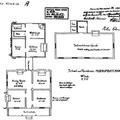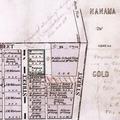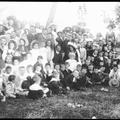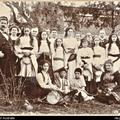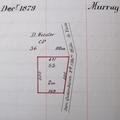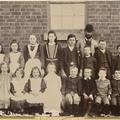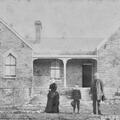< Early Canberra Government Schools
Murrumbateman School [1869 - 1973]
Murrumbateman had a school as early as 1869 and several other schools opened in the surrounding district between 1875 and 1918. The Secretary of the Council of Education received advice from the Colonial Secretary's Office on 4 February 1869 that two acres of land had been appropriated for Public School purposes at the south east corner of David Webster's conditional purchase of 110 acres (Portion 36 Parish of Morumbateman[sic]) at Murrumbateman Plains with a frontage of five chains to the Yass-Queanbeyan Road. Francis Forbes of Murrumbateman wrote to the Council of Education seeking advice as to whether the local school committee could proceed with the erection of a school on the land made available and received approval to go ahead.
An application from John Gibson dated 26 June 1869 for the establishment of a Provisional School at Murrumbateman followed, in which Edwin Jobson was nominated as teacher. The local committee comprise David Webster, Francis Forbes and George Lucas. The parents who undertook to send children to the school were David Webster, Arthur Webster, Thomas Armstrong, William Carter, George Lucas, John Greig, Arthur Carter, Edwin Lucas, Thomas Johns, Michael Hollingsworth, Archibald Marshall and George Vallance. A letter from Francis Forbes to the Council indicated that the teacher had already arrived and commenced teaching in a building secured pending completion of the school building, which was soon to be ready. The letter sought aid with the provision of furniture.
Teacher Jobson had been trained in England and taught at Gunning for nine months before coming to Murrumbateman. In 1871 David Webster, Secretary of the local board wrote seeking assistance to build a new school. The plans originally submitted were rejected by the Council's architect but revised plans received approval. The Council agreed on 22 May 1871 to the acceptance of David Howell's tender of ₤109 for the erection of the school and to meet two thirds of the cost. Webster wrote again on 18 December 1871 indicating that the building had been completed. Edwin Jobson informed the Council of Education in a letter of 5 July 1872 that attendance at the school for the previous three months had averaged 25.1 and sought an increase in salary. He was informed that before a higher salary could be paid the school must become a Public School. This resulted in a letter of 22 July 1872 from Hugh Vallance senior, George Lucas and David Webster seeking conversion of the school to Public status. The conversion was approved by the Council on 22 August 1872.
Edwin Jobson tendered his resignation at the end of June 1874 in order to attend the Public Training School at Sydney and was replaced by William John Chapman. Allotments 132, 138 and 139 in the village of Murrumbateman were made available for school purposes in the late 1870s but no buildings were erected on this land, it being used by teachers as a horse paddock.
William Chapman submitted his resignation in May 1880 because of charges made against him in relation to interference with girls. The charges were found to be without foundation and he sought to withdraw his resignation, but he had already been appointed to another school and George Vincent had taken his place. Vincent resigned in March 1882 and he was followed by several teachers who stayed no more than two or three years. Additions were made to the school in 1885 at a cost of ₤98, G. Thomson and G. Bates being the contractors.
William Fairley, who came to the school in August 1902, remained until April 1909 and later teachers Edward Connelly, Alan Joseph Daly and Patrick Michael McGrath each remained for lengthy periods. The school continued under various other teachers until it closed in 1973 when arrangements were made for the children to be taken by bus to Yass School.
[Lyall Gillespie, 'Early education and schools in the Canberra region, 59-60]
The school buildings
The Department of Lands was approached to provide the land for the school building and on 30 January 1869 two acres of land at the south-eastern corner of David Webster's Cond tional Purchase, with a frontage of five chains to the Yass - Queanbeyan Road, was appropriated. The surveyor marked out the site for the school and the committee started raising the necessary funds to erect the building. The collectors had some trouble in raising the required amounts. The correspondent to the Yass Courter commented tersely - 'that subscription lists are in circulation in one of which we saw the names of persons for very paltry amounts, who largely subscribe to horse racing'.
Tenders were called and that of A D young and R Webster was successful. The slab building with a bark roof was erected at a cost of ₤39.2.4.d. The building contained two rooms, one for the teacher's residence, the other a school room.
......Following heightened community awareness of the value of education, it was decided in April l87l that a more substantial school was needed to cope with an upsurge of enrolments. Plans were drawn up and tenders called. The successful tenderer, David Howell, signed an agreement with David Webster, Francis Forbes, George Lucas, George Vallance and Edwin Lucas on behalf of the school committee on l0 June 1871. Building commenced and thirty eight trees and stumps were cleared, a fence, together with a gate, was erected and a tank installed, in readiness for the big opening. A tea meeting was held on Thursday 21 December l87l to celebrate the school's completion. Tickets were two shillings each. Archdeacon Lillingston, the Rev. J Gibson and sundry other gentlemen addressed the gathering and prizes were presented to the most deserving pupils.
The old slab building then became the teacher's residence. The bark roof had worn out and shingles were used to replace the bark. Two water closets, of slab and shingle con- struction, were also built..........The local subscription for the building was ₤36.6.8, a little more than a third of the contract price of ₤109. ......A weathershed was erected in July 1874. A month later a blackboard, wash stand, basins and a school bell were purchased.
......By 1875 the teacher's residence, formerly the slab school building had become very cramped. Plans for a two-room residence were drawn up, but they were lost in the mail. New plans were then drawn for a three-room residence and the work was completed by John Colls, building contractor of Yass, at a cost of approximately ₤430. The original slab building was retained as a detached kitchen. The local community had become more involved in raising the necessary monies to support their school and they were able to contribute ₤104.11.6 towards the cost of the residence, compared with the ₤121.3.4 paid by the Council of Education. In 1885 increasing enrolments led to the enlargement of the school building.
By 1888 many mothers had become concerned because there were no shelter trees in the school grounds. Moreover, the children were coming home in a filthy condition because of the dirt floors in the weathershed. The trees that were planted were to form the essential nucleus and inspiration for later garden development The flooring and repairs to the weathershed were carried out with some haste by David Webster.
The beginning of the new year in 1890 saw problems with seepage of sanitary waste from the pit toilet into the well used by the teacher and his family. The problems were following a predictable pattern experienced in many other localities. Typhoid fever was becoming a common illness and seepage of this kind was notorious for infecting the drinking water in underground wells. Typhoid fever again hit the district in April 1894 and Alfred Borman, Chairman of the School Board, requested that the pit toilets be emptied, because they were very full. Ceorge Butt carried out this unenviable task. The pit toilets had been sunk in a bed of clay which held the contents like a tank. He requested that new toilets be built.
....ln December 1915, a considerable amount of work was begun on the teacher's residence, including a verandah on the northern side of the building and french doors on to the verandah. Three existing toilets were removed and the pits filled in and three new toilets erected. A concrete dome was constructed over the well The floor of the covered walkway to the kitchen area was replaced; a sink was placed in the kitchen and wash tubs in the laundry. The residence and school were painted externally and internally.
[Edited extracts from D Mulholland,'Far away days', Ch 8 Murrumbateman school]
Obituary : Lat Mrs Margaret Sarson
One Of The Yass District's Oldest Pioneers
Probably, every man, woman and child in the town and district knew, or knew of, Mrs. Margaret Sarson, who passed away at 'Hawthorn,' Murrumbateman, about 5 o'clock on Tuesday afternoon. By the old lady's death, which is regretted throughout the entire community, a link with the past has been severed.
Mrs. Sarson had reached the grand old age of 96 years, and would have been 97 on October 5 this year. She was a lovable old lady, and during her long stay on this earth, went through many trials and tribulations. Born in Scotland in 1833, she came to New South Wales with her father Hugh Vallance, when she was a young girl in 1840. The late Mr. Vallance was engaged by John Hosking of 'Foxlow', one of the oldest estates in N.S.W., now owned by the Falkiners. Mrs. Sarson was probably the oldest pioneer in the district. She was the first settler on Murrumbateman, having purchased a block of land from John Hosking, then Mayor of Sydney, to which she added when Sir John Robertson's Free Selection Act came into force in 1860.............
The first school in Murrumbateman was held in a room of Mrs. Sarson's house, which she provided free of charge for the purpose, and also boarded the teacher gratis. The respective parents of scholars paid the sum of one shilling per week for each child, and the late James Ramsay (of Johnston and Ramsay), Nanima, donated £25 per annum, a most generous action, as that gentleman was then only a newcomer to the district.
[Yass Tribune-Courier, Thursday 20 June 1929, p 2]
Location Map
Related Photos
Teachers
- Jobson, Mr Edwin
07/1869 - 06/1874 - Chapman, Mr William John
07/1874 - 08/1880 - Vincent, Mr George
09/1880 - 03/1882 - Mansfield, Mr Charles
04/1882 - 04/1884 - Brettell, Mr Henry
04/1884 - 05/1886 - Kelly, Mr Joseph
05/1886 - 11/1889 - Dyce, Clarence
11/1889 - 08/1902 - Fairley, Mr William
08/1902 - 04/1909 - Bluett, Mr Ed
04/1909 - 05/1909 - Fraser, Mr Henry
05/1909 - 10/1913 - Gould, Mr E T
10/1913 - 12/1918 - Connelly, Mr Edward
01/1919 - 08/1929 - Daly, Mr Alan Joseph
08/1929 - 12/1936
Related Documents
Teacher biographic:
- From London stationer to colonial teacher. (PDF 3.8 Mb)
NSW Government schools from 1848
- Murrumbateman School (external link)
< Early Canberra Government Schools
If you are able to assist our work of identifying, documenting, and celebrating the early bush schools of the Canberra region, please contact us or .


